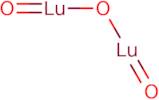Lutetium oxide
CAS: 12032-20-1
Ref. 3D-MAA03220
| 1g | Descontinuado | ||
| 2g | Descontinuado | ||
| 5g | Descontinuado | ||
| 10g | Descontinuado | ||
| 25g | Descontinuado | ||
| 25mg | Descontinuado | ||
| 100mg | Descontinuado | ||
| 250mg | Descontinuado | ||
| 500mg | Descontinuado |
Informação sobre produto
- Dilutetium trioxide
- Lutecium oxide
- Lutetia
- Lutetium Oxide
- Lutetium oxide (Lu<sub>2</sub>O<sub>3</sub>)
- Lutetium sesquioxide
- Lutetium sesquioxide (Lu<sub>2</sub>O<sub>3</sub>)
- Lutetium trioxide
- Lutetium(3+) oxide
- Lutetium(III) oxide
- Ver mais sinónimos
- Lutetiumoxid
- Oxido De Lutetio
- Oxyde de lutetium
- oxygen(-2) anion
- LutetiumoxideREOwhitepowder
- Lutetium (III) oxide (99.999% Lu) (REO) Puratrem
- lutetium(+3) cation
- Lutetium(III) oxide (99.9% Lu) (REO)
- LutetiumoxideREOPuratrem
- Lutetium oxide (Lu2O3)
Lutetium oxide is a chemical compound that is stable under normal conditions. It has a high resistance to hydrochloric acid and other inorganic acids. Lutetium oxide has a particle size of 5-100 nm, which is suitable for use as a light-emitting material. The emission spectrum of Lutetium oxide can be altered by the addition of gadolinium or other rare earth metals. The reaction mechanism of Lutetium oxide is not well understood, but it is suspected to be due to the formation of lutetium hydroxide ions.





